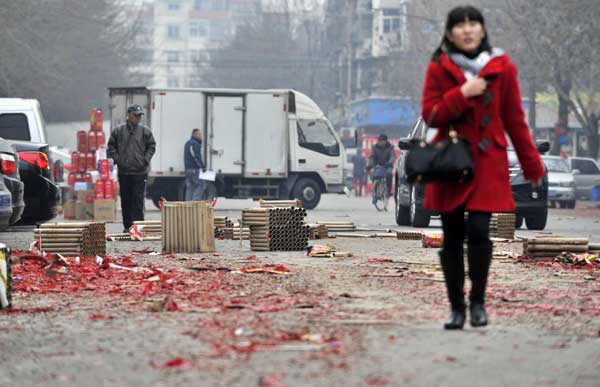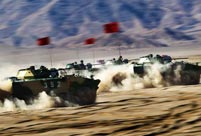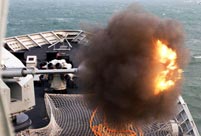 Cockfighting show staged in E. China's Heze during Spring Festival
Cockfighting show staged in E. China's Heze during Spring Festival
 Chinese New Year Flower Fair opens in San Francisco
Chinese New Year Flower Fair opens in San Francisco
 Festivities in Shanghai
Festivities in Shanghai
 PLA navy conducts drill in North China Sea
PLA navy conducts drill in North China Sea
 World's high-tech hotels
World's high-tech hotels
 Li Na poses with trophy on Brighton Beach in Melbourne
Li Na poses with trophy on Brighton Beach in Melbourne
 Six Chinese divers back safely after 300-meter saturation dive
Six Chinese divers back safely after 300-meter saturation dive
 Traditional wedding ceremony of Yao people
Traditional wedding ceremony of Yao people
 Taipei Game Show attracts geeky gamers
Taipei Game Show attracts geeky gamers
 |
| A woman walks past firework paper wastes in Tianjin January 31, 2014. [Photo/Xinhua] |
China sees less smog during the lunar new year celebrations, as people have shown "quiet" support for the government call for fewer fireworks.
Most of the megacities reported less air pollution, good visibility and less noise on the eve of China's Spring Festival. The Spring Festival falls on Friday this year.
Beijing's air quality on the eve of the Spring Festival was "much better" than last year with the average PM 2.5 reading between 140-160 micrograms per cubic meter from 6 p.m. on Thursday to midnight.
The municipal environmental monitoring center said that last year, Beijing recorded its highest ever reading (over 1,000) after a firework frenzy on the lunar new year's eve.
The capital also had fewer fires and injuries on Thursday night.
The municipal government was so thrilled that it expressed gratitude in a public letter on Friday to local citizens who answered its call of replacing fireworks with flowers and electronic substitutes for celebrations.
The letter also calls for continuing such "environment-friendly " practices in coming days.
Harbin, the capital of northeast Heilongjiang Province, also experienced a rare clean lunar new year's eve as the average PM 2.5 reading stood at 103 micrograms per cubic meter after the pyrotechnic peak at midnight.
Chinese people light firecrackers and fireworks to celebrate the Spring Festival, the beginning of the lunar new year. Traditionally, the noise was believed to scare away evil spirits and bad luck. However, with regular smog suffocating China in recent years, the contribution of fireworks to air pollution has drawn the attention of authorities.
Posts and cheesy one-liners calling for people not to set off firecrackers are circulating on Chinese social media platforms.
"The efforts has paid off, but we definitely need to do more," Tang Lili, an official with the environmental monitoring center of east China's Jiangsu Province told Xinhua, referring to an air quality report.
The report showed the peak PM 2.5 reading on Thursday night and Friday morning was 568 micrograms per cubic meter, a remarkable drop compared with last year's 800, but still far above "clean".
"Factories have been closed for the holiday and there are far fewer cars on road, so the fireworks are the main pollutant," said Tang.
"We still have a long way to go to raise public awareness and the government should take tough measures when necessary," she said.
In this regard, Beijing takes the lead. The capital cut the number of licensed firecrackers and fireworks retailers by 12 percent this year to 1,178 stalls. For the first time, municipal authorities required retailers to record the identities and phone numbers of buyers of more than five boxes of fireworks. If the customer refuses to give the information, retailers are obliged to refuse sale or sell a smaller amount.
Statistics on fireworks and firecrackers from the Beijing municipal office showed as of Thursday, more than 126,000 boxes of fireworks had been sold, down 52 percent from last year.
In December, the office announced an emergency ban on fireworks if orange or red air pollution alerts were issued.
An orange alert means forecast pollution of over 300 micrograms per cubic meter for the following 24 hours, or of over 200 micrograms per cubic meter for 72 hours.
Residents receive cell phone text messages notifying them of alerts, and the police will prevent the public from flouting the ban, said Yu Lianwei, an official with Beijing's public security bureau.
 3D film 'The Monkey King' premieres in Beijing
3D film 'The Monkey King' premieres in Beijing  Miss Chinese Int'l Pageant 2014 held in Hong Kong
Miss Chinese Int'l Pageant 2014 held in Hong Kong 'Golden Flowers' in the Spring Festival travel rush
'Golden Flowers' in the Spring Festival travel rush Li Na beats Cibulkova to win Australian Open
Li Na beats Cibulkova to win Australian Open Sexy models at Taipei Game Show 2014
Sexy models at Taipei Game Show 2014 'Living in ice house' competition held in central China
'Living in ice house' competition held in central China  Highlights of Chinese airborne troops'exercises
Highlights of Chinese airborne troops'exercises  All-male high speed train crew during Spring Festival travel rush
All-male high speed train crew during Spring Festival travel rush PLA navy drills in East China Sea
PLA navy drills in East China Sea President Xi visits border troops ahead of Lunar New Year
President Xi visits border troops ahead of Lunar New Year What do Chinese pack in their luggage in Spring Festival Rush?
What do Chinese pack in their luggage in Spring Festival Rush? Blind date fair in Hangzhou of Zhejiang province
Blind date fair in Hangzhou of Zhejiang province Film 'Where Are We Going, Dad' premiered in Beijing
Film 'Where Are We Going, Dad' premiered in Beijing  Australian Open champion Li Na returns to hometown Wuhan
Australian Open champion Li Na returns to hometown Wuhan Twin sisters serve during Spring Festival travel rush for the first time
Twin sisters serve during Spring Festival travel rush for the first timeDay|Week|Month